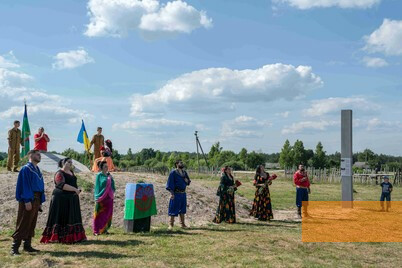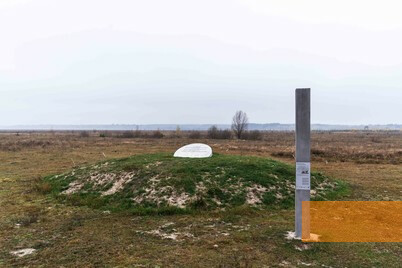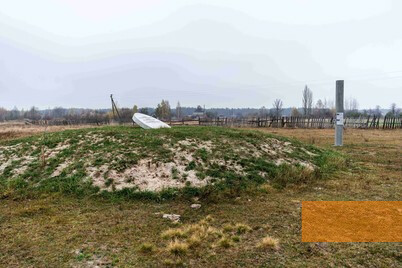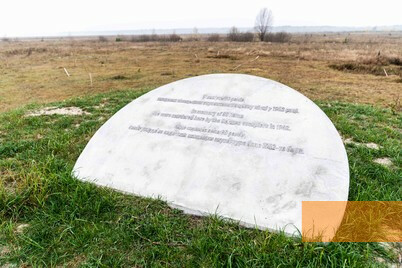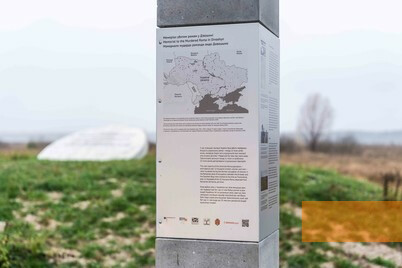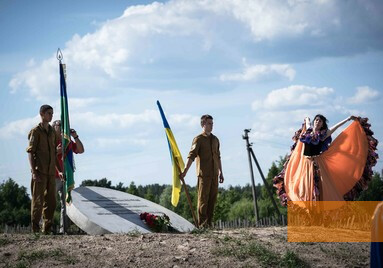On the outskirts of Divoshin, a village in Northern Ukraine, a memorial was constructed in 2019 to commemorate 80 Roma who had been murdered there. The names of the victims are unknown.
Aside from Jews the Nazis also persecuted Sinti and Roma out of racist motives. As elsewhere, Roma became a target of Nazi extermination policies also in the occupied territories of the Soviet Union. They used violence against both settled and nomadic groups of Roma. Often, they murdered whole groups at the same time.
On the outskirts of the village Divoshin near the Belarusian border, at least 80 Roma were murdered in the summer or autumn of 1942. The group had previously been expelled by the village elder of the Belarusian village of Kozly. German cavalry intercepted the group and accused them of partisan activity. The Germans forced them all into a stable. According to locals, the men were rounded up the next morning and taken to nearby clay-extraction pits, which they were made to dig deeper before being shot. Thereafter the women were raped and then shot along with the children. Some of the villagers heard the screams and shooting.
On the outskirts of the village Divoshin near the Belarusian border, at least 80 Roma were murdered in the summer or autumn of 1942. The group had previously been expelled by the village elder of the Belarusian village of Kozly. German cavalry intercepted the group and accused them of partisan activity. The Germans forced them all into a stable. According to locals, the men were rounded up the next morning and taken to nearby clay-extraction pits, which they were made to dig deeper before being shot. Thereafter the women were raped and then shot along with the children. Some of the villagers heard the screams and shooting.
At least 80 Roma were murdered on the outskirts of Divoshin in the summer or the autumn of 1942. The names of the victims could not be identified yet. During the German occupation presumably the majority of Roma in the Ukraine have been murdered - the estimated number of victims is 12,000 children, women and men.
There was no investigation by Soviet authorities into the murder of the Roma in Divoshin after the war. The inhabitants of the village, for whom the victims had been strangers, also did not feel themselves responsible to take care of the mass grave.
In the 1970s the field with the mass grave was levelled and the land was repurposed for agricultural use. After 2000, local actors, above all Konstiantyn Bondarchuk from the neighbouring village of Pokaliv and Igor Krikunov, director of the Roma theatre »Romans« in Kiev, tried to gather as much information as possible about the massacre in Divoshin. Together with local historian Yakiv Hryshchuk, they have pushed for the creation of a memorial site.
As part of the international project »Protecting Memory« which is based at the Berlin office of the Foundation Memorial to the Murdered Jews of Europe, a »Forest of Memory« was planted in the field where the murders are presumed to have been committed. Eighty trees symbolically represent each of the victims. Also, a memorial stone was inaugurated with an inscription in Ukrainian, English and Romani language. The inscription reads: »In memory of 80 Roma who were murdered here by the German occupiers in 1942«, An information column informs on the historical background of the memorial site.
In the 1970s the field with the mass grave was levelled and the land was repurposed for agricultural use. After 2000, local actors, above all Konstiantyn Bondarchuk from the neighbouring village of Pokaliv and Igor Krikunov, director of the Roma theatre »Romans« in Kiev, tried to gather as much information as possible about the massacre in Divoshin. Together with local historian Yakiv Hryshchuk, they have pushed for the creation of a memorial site.
As part of the international project »Protecting Memory« which is based at the Berlin office of the Foundation Memorial to the Murdered Jews of Europe, a »Forest of Memory« was planted in the field where the murders are presumed to have been committed. Eighty trees symbolically represent each of the victims. Also, a memorial stone was inaugurated with an inscription in Ukrainian, English and Romani language. The inscription reads: »In memory of 80 Roma who were murdered here by the German occupiers in 1942«, An information column informs on the historical background of the memorial site.
- Name
- Місце пам’яті вбитим ромам у Дівошин
- Web
- https://www.erinnerungbewahren.de/divoshin/
- info@erinnerung-bewahren.de
- Open
- The memorial is accessible at all times.


